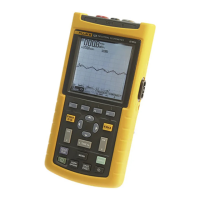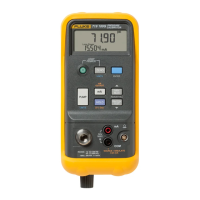123
Service Manual
4-6
ST7968.CGM
Figure 4-2. Menu item selection
If an item is selected, it is marked by ■. Not selected items are marked by . If a
selected item is highlighted, an then
is pressed, the item remains selected.
You can also navigate through the menu using
. To conform the highlighted item
you must press
.
4.5.1 Input A and B Base Line Jump Test
Proceed as follows to check the Input A and Input B base line jump:
1. Short circuit the Input A and the Input B shielded banana sockets of the test tool.
Use the BB120 banana to BNC adapter, and a 50Ω (or lower) BNC termination.
2. Select the following test tool setup:
• Turn Input B on (if not already on).
• Press
to select auto ranging (AUTO in top of display).
(
toggles between AUTO and MANUAL ranging).
• Press to open the SCOPE INPUTS menu.
• Press
to open the SCOPE OPTIONS menu, and choose :
SCOPE MODE: ■ NORMAL | WAVEFORM MODE: ■ SMOOTH
3. Using toggle the time base between 10 ms/div and 5 ms/div.
(the time base ranging is set to manual now, the input sensitivity is still automatic; no
indication
AUTO or MANUAL is displayed).
After changing the time base wait some seconds until the trace has settled.
Observe the Input A trace, and check to see if it returns to the same position after
changing the time base. The allowed difference is ±0.04 division (= 1 pixel).
Observe the Input B trace for the same conditions.
4. Using
toggle the time base between 1 µs/div and 500 ns/div. After changing
the time base wait some seconds until the trace has settled.
Observe the Input A trace, and check to see if it is set to the same position after
changing the time base. The allowed difference is ±0.04 division (= 1 pixel).
Observe the Input B trace for the same conditions.

